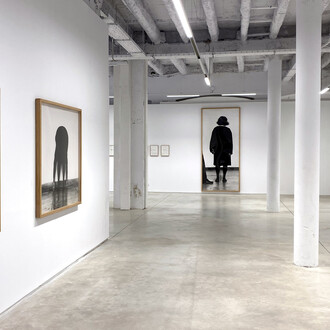Pliny the Elder’s account of the origin of painting is narrated in his Natural History (circa 77-79AD) as a consequence of an absence. He tells the story of the potter Butades of Corinth and how his daughter Kora drew a charcoal silhouette of her lover’s head on the wall, following the shadow projected by candlelight, in order to preserve his image, or perhaps, as purported in primitive rites, also his soul. According to Derrida the drawing emerges from the absence and invisibility, from the need to represent something that exists only in memory: when Kora draws her lover’s outline she doesn’t see him, he disappears from her gaze as she makes the brush-stroke, the image comes from memory in her lover’s absence.
Anne-Lise Coste is known for her radical approach, in which the creative potential of her art is articulated in the spontaneous gesture and what is directly said, written and painted. In her works, Coste opposes the standardization of art and uncompromisingly points out the fleeting nature of the moment. Drawing plays a main role in portraying a universe based on her idiosyncratic codes: her imagination and daily life being the raw material that inspires her works. In Vessels Coste also incorporates a performative character where absence underpins her impulse to paint. Like Ana Mendieta’s Sandwomen, Coste uses her own body to describe the forms of other bodies (perhaps her own), combining a concern with primal rituals and a modern, feminist sensibility.
Anne-Lise Coste was born in Marignane, France, in 1973. Lives and works in Orthoux, France. Coste has taken part in numerous exhibitions, among which: Sors le monde, La FabriC, Fondation Salomon Art Contemporain, Annecy, France (2019); Ton Crâne, Mon Crâne, Reinhard Hauff Gallery, Stuttgard, Germany, (2018); Entusiasme. El repte i l ́obstinació en la Colecció MACBA, MACBA, Barcelona, (2018); Inside Intensity The Anniversary Show, Museum Kurhaus, Kleef, Germany (2017); Things are getting better all the time..., Helmhaus, Zurich, Switzerland (2017); La conquête de l’espace, la chute des feuilles, les neiges éternelles, l’avancée des déserts, la puce électronique, Ellen de Bruijne Projects, Amsterdam, Netherlands (2017); ONLY LOVERS, Le Coeur Paris, Paris, France (2015); Blackboard-White page!, Kantonsschule Zürich Nord, Zurich, Switzerland (2014); Critical Episodes (1957-2011). Colección MACBA, Caixaforum, Barcelona, Spain (2013); Laat je haar neer (Let Your Hair Down), Boijmans van Beuningen Museum, Rotterdam, Netherlands (2013).
It is the dislocated nature of the condition -between seeing what one wants to represent and not seeing it- which leads Anne-Lise Coste to produce the series Vessels, 2019 presented in this exhibition. A certain feeling of melancholia is conveyed through the repetition of elementary figures that at first glance we don’t fully comprehend, but that we can follow in emotional terms, making us accomplices of Coste's inner world with a sensitivity as heartbreaking as it is poetic. In the tracing of these forms one can appreciate the hand of the artist dragging the painting: it is Anne-Lise Coste herself who has not disappeared in these works of immense solitude.
In Thinking of you (body and soul), these forms in the shape of bodies also recall still lives. John Berger pointed out in a lecture given at the Museo del Prado in 1999 dedicated to the still lifes in the collection that perhaps the true theme of these paintings was the infinity of the darkness in the background, where everything vanishes; however, in the works of Anne-Lise Coste, as in Corinth when the flame dies and plunges everything into darkness, a line remains cutting the void like a knife: tracing the profile that will replace the imminent absence.
















